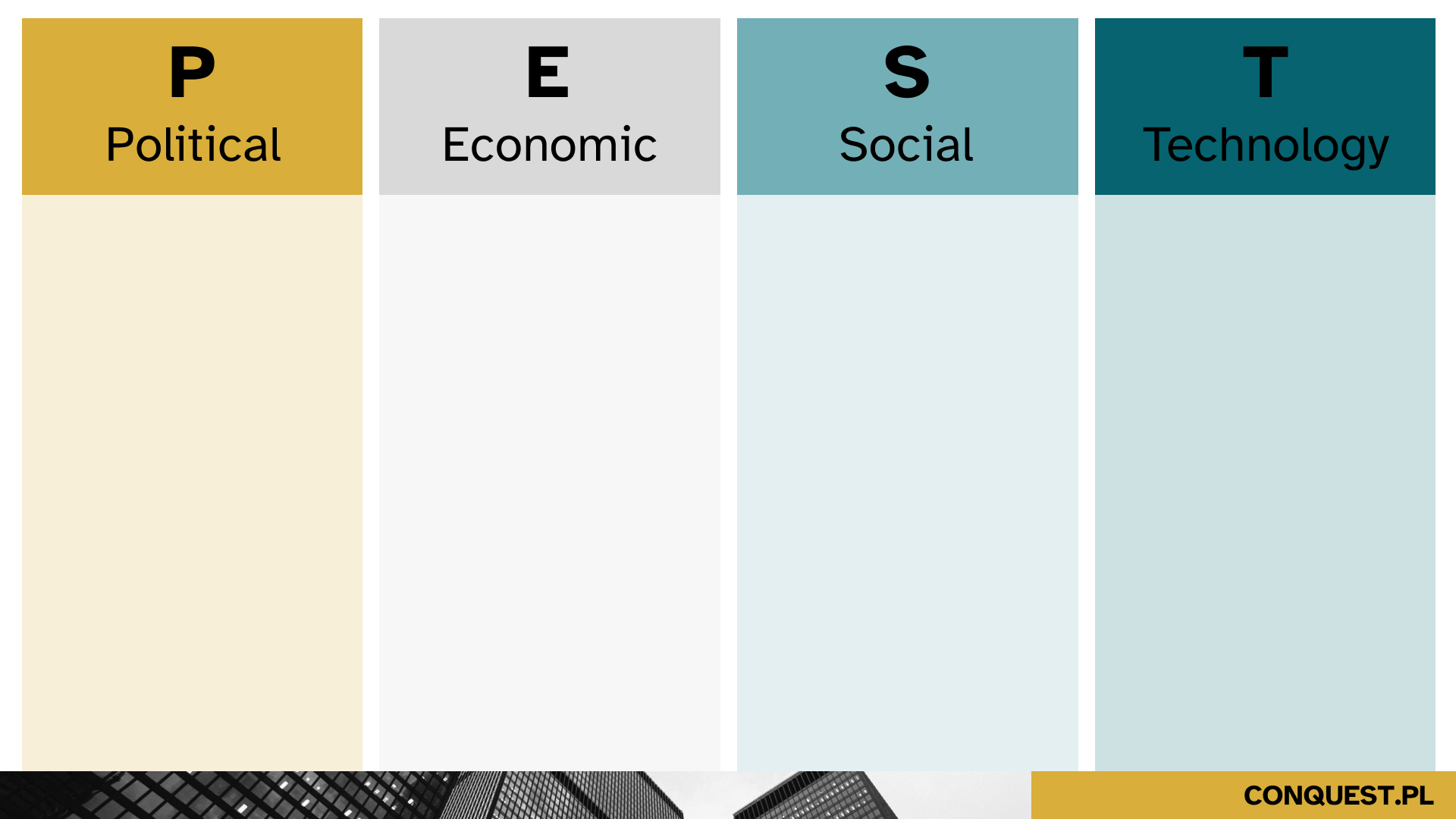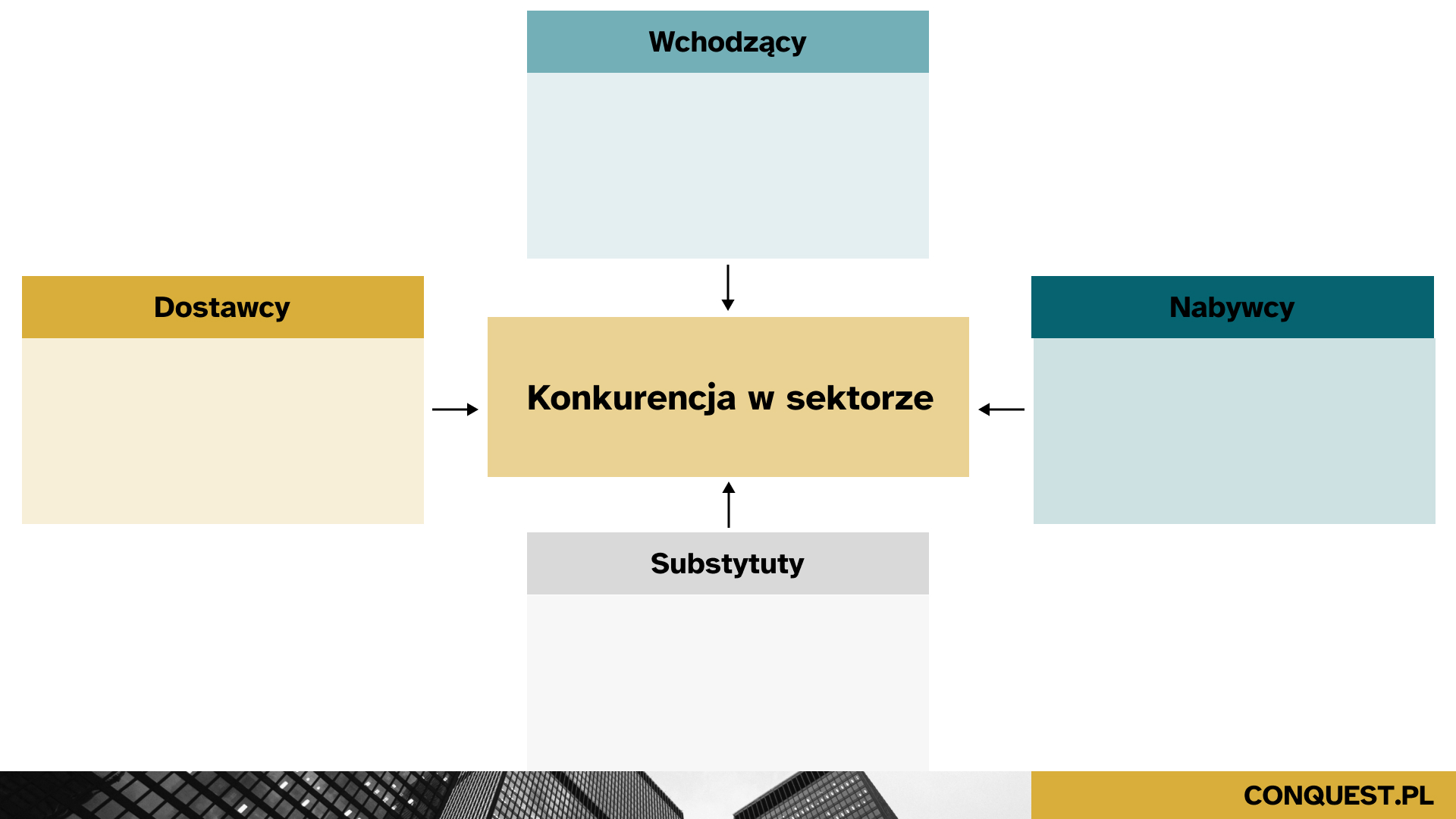22.03.2023
PEST analysis as part of market research
Key information:
- The authorship of the concept of PEST analysis is attributed to Harvard professor Francis Aguilar.
- PEST analysis is used to assess four types of external factors (political, economic, socio-cultural and technological) in relation to a company's business situation.
- The PEST analysis helps determine how the factors listed may affect the company's performance and operations in the long term.
- A more elaborate version of the company's PEST analysis is the PESTEL analysis, which additionally takes into account environmental factors (Environmental) and legal factors (Legal).
- The three main stages of PEST analysis are: identifying the relevant factors relating to each segment of the environment, assessing the impact of each factor on the organization's performance, and determining the relationship between the company and its macro environment.
- When analyzing political factors, it is important to consider all issues related to the political and legal situation of the country in which the company operates or plans to operate.
- The analysis of economic factors should include information on the country's economic situation.
- Socio-cultural factors include issues related to a country's demographics.
- When analyzing technological factors, the country's level of innovation is taken into account.
- Once the factors in the company's macro environment have been identified, it is necessary to assess which of them will have a positive (opportunities) and which will have a negative (threats) impact on the company's operations.
- The purpose of conducting a PEST analysis is to take a bird's-eye view of the organization, allows you to take appropriate action to improve the overall health of the company, strengthen its position in the market and gain a competitive advantage.
- The most commonly conducted along with PEST analysis are SWOT analysis and Porter's 5 forces analysis.
- PEST analysis is a valuable tool when building an organization's operations strategy.
Details below!

What is a PEST analysis?
PEST analysis is used to assess four types of external factors (political, economic, sociocultural and technological) in relation to a company's business situation.
One of the tools used to analyze macro environment of the company is the PEST analysis. The authorship of this concept is attributed to Harvard professor Francis Aguilar, who described a tool called ETPS (later renamed PEST) in 1967 in his book "Scanning the Business Environment."
The name is an acronym for four English words that stand for particular groups of factors from a company's environment. These are: political factors (Political), economic factors (Economic), sociocultural factors (Social/Socio-cultural) and technological factors (Technological). An entrepreneur planning to do business in a particular market should consider each of the above-mentioned environments.
There is also a more elaborate variation of the PEST analysis, which additionally takes into account environmental factors (Environmental) and legal factors (Legal). The analysis is then called PESTEL.
Stages of PEST analysis
The PEST analysis consists of three main stages.
- Identification of relevant factors for each segment of the environment.
- Evaluate the impact of each PEST analysis factor on organizational performance.
- Identify the relationship between the company and its macro environment.
PEST analysis step by step - example
In order to present the various steps of the analysis in an easily digestible way, an example of a PEST analysis for a rehabilitation equipment company that plans to enter a foreign market is presented. The PEST analysis should begin by identifying the various aspects that can affect the company's operation in a given market. These should be broken down according to the different segments of the environment.
Political factors
As the name suggests, this stage of the PEST analysis should take into account any issues related to the political and legal environment of the country in which the business is planned. A rehabilitation equipment manufacturer should therefore look at:
- The country's political stability,
- tax system,
- Issues related to importing medical equipment in a country (if planning to operate in a foreign market),
- the process of registration and marketing of medical equipment in the country (relevant administrative bodies, required documents, time and cost of registration, the need for an authorized representative),
- regulations related to the hiring of employees.
The analysis of political factors provides insight into the system of regulations governing the company's operations in a particular country.
Economic factors
This part of the PEST analysis should include information on the economic situation of the country where you plan to open a business. This includes such data as:
- interest rate levels,
- inflation,
- economic growth,
- unemployment rate.
In addition to making the PEST analysis more tailored to the business profile of the company used as an example, it can include data related to the economic environment of the medical equipment market - its value, forecasts related to it and trends in it.
Socio-cultural factors
Socio-cultural factors include issues related to a country's demographics. Under analysis are:
- The stage of demographic development of society (birth and death rates),
- Consumers' preferred lifestyle,
- traditions and customs,
- education level,
- shopping habits,
- health awareness,
- prevailing family structure,
- The public's attitude toward foreign and domestic goods.
These factors have a major impact on the business. In Iran, for example, disability is seen as a cause for shame, and people with disabilities are hidden, so demand for rehabilitation equipment is low.
Technological factors
When analyzing the technological factors of the PEST analysis, such aspects should be taken into account to learn about the technological level of a particular market. In the case of a rehabilitation equipment manufacturer, factors such as:
- The country's level of innovation,
- All kinds of tax incentives related to R&D activities,
- The existence of new technologies that the company can use,
- competitors' access to new technologies that can modify their products,
- priority areas targeted by the country's innovation policy.
The technological environment is of particular importance for an organization that plans to open production facilities in a particular market. If the geographic expansion is only to sell products abroad, technological factors in a foreign market are not so crucial.
PEST method worksheet
If you are facing the challenge of preparing a PEST analysis, the following worksheet may be helpful for you!

Identification of threats and opportunities and company actions
After determining the factors present in macro environment enterprise, it is necessary to assess which of these will have a positive (opportunities) and which negative (threats) impact on the company's operations. Opportunities for a medical equipment manufacturer, for example, may include the short registration process for such products or the growing health awareness of the public. Threats could include, for example, the previously mentioned approach to people with disabilities in Iran or the lack of reimbursement of medical equipment by the public health service.
The final step in the PEST analysis is to identify actions to take advantage of existing opportunities and avoid risks.
If you need support in conducting a market analysis, contact us!
What is the purpose of conducting a PEST analysis?
Taking a bird's-eye view of the organization allows you to take appropriate action to improve the overall health of the company, strengthen its position in the market and gain a competitive advantage. In addition, the information gained during PEST analysis can help generate more profits and avoid failures.
Important decisions in the life of a company should not be made on impulse or intuition, but should instead be supported by concrete information and preceded by adequate market research. In order to obtain an analysis macro environment of the company It is worth turning to a consulting firm specializing in such services. A correctly conducted PEST analysis will help the entrepreneur make the right decisions about the development of his business.
If you need to analyze the market in which you operate and do not know how to do it, check out how we helped To our customers in a similar situation.
When is PEST analysis used?
PEST analysis is a particularly helpful tool for companies that are just starting out or planning to expand into foreign markets. Analysis macro environment of the company is also an action worth taking if the organization is struggling with a loss of market position, declining profits or a general decline in the company's condition.
Where to look for information for PEST analysis?
To find information useful for conducting a PEST analysis, you may want to use:
- Yearbooks and guides of the CSO and the CSO (Provincial Statistical Office),
- prospectuses,
- banking publications,
- Training, seminars and conferences,
- Companies' annual reports,
- publications of scientific institutions,
- mass media,
- statute books,
- trade journals,
- web portals,
- fairs and exhibitions.
It is important to remember that any source from which information is drawn should be verified. Such an action will avoid errors when conducting a PEST analysis, guaranteeing reliable results.
Other useful business analysis
Often for analysis macro environment enterprises use PEST analysis in cooperation with other tools, which provides a clear understanding of the situation and allows linking internal and external factors. The most common conducted along with PEST analysis are:
Porter's 5 forces analysis worksheet

PEST analysis is a valuable tool when building a company's operations strategy
A properly conducted PEST analysis reveals what risks can affect the operation of a company. Subjecting the organization's macroeconomic environment to analysis allows you to gain information about areas that are often overlooked or forgotten. It is worth remembering that in order to get the best picture of the market situation, it is necessary to conduct a thorough market analysis. This will make it easier to acquire or maintain a strong market position.




